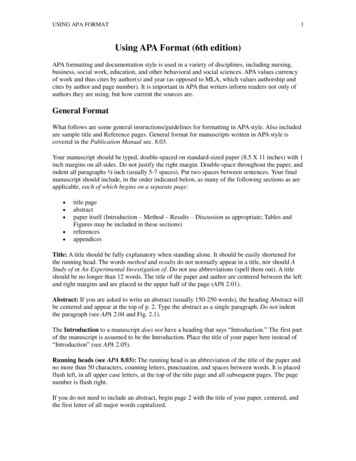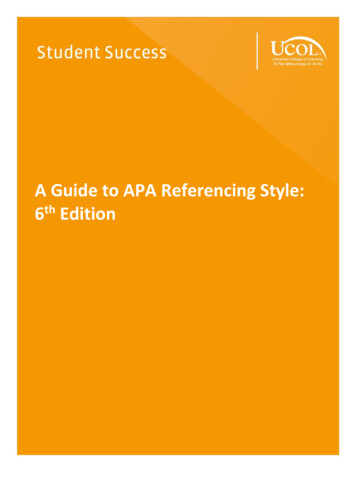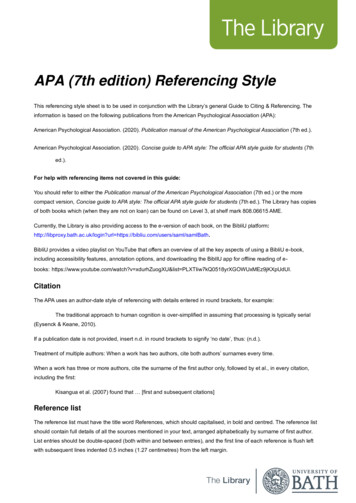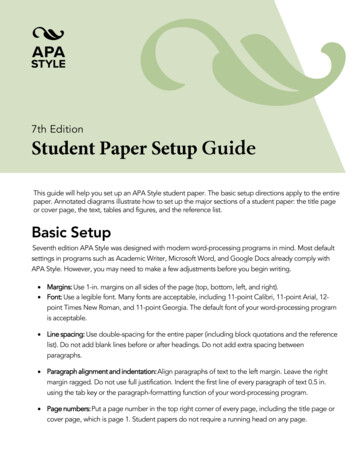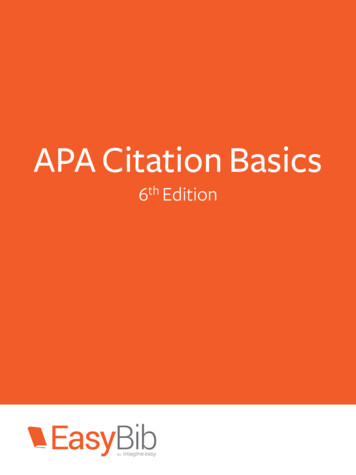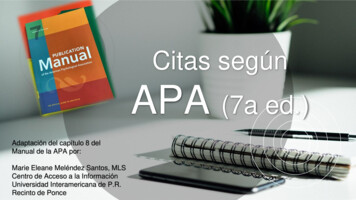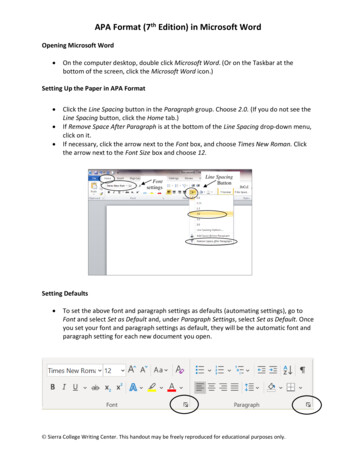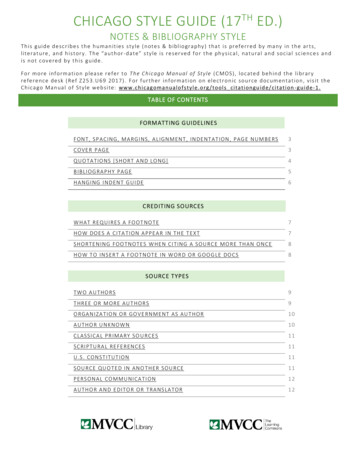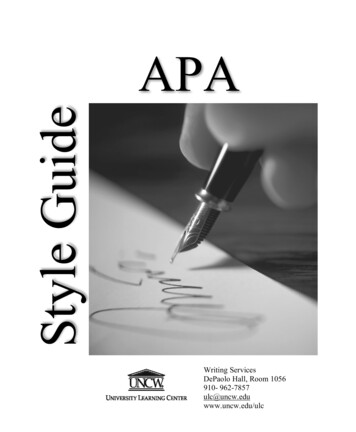
Transcription
Style GuideAPA1Writing ServicesDePaolo Hall, Room 1056910- 962-7857ulc@uncw.eduwww.uncw.edu/ulc
Revised October 20212
ContentsThe handbook that lists the rules and conventions of APA style is the Publication Manualof the American Psychological Association. The seventh and most current edition waspublished in 2020, and in it, you will find the following examples and more.TopicPageAPA Style Hints. 5-6APA Sample Paper . 7-9In-Text CitationsOne work by one author . 10One work by multiple authors . 11Groups as authors . 11Unknown author . 11ReferencesReference to an entire book. 12Edited book . 12Journal article . 12Magazine article . 12Newspaper article . 13Report by government agency . 13Film or TV . 13Religious work . 13Artwork . 14TED talk . 14Webpage with group author. 14Document available on university program or department web site . 14Instagram photo . 14Example sheet. 15Reference . 163
APA Style Hints * Italics are used for titles of books, reports, webpages, and other stand-alone works.You do not use italics for the title of a book series i.e.: the Harry Potter series. Entries in reference lists should follow the hanging indent format: the first line isflush left, and the second and subsequent lines should be indented. The ampersand (&) is used to stand for “and” in citations and on your referencespage (not in the text of your paper).In the titles of journal articles, book chapters, and books, the first word and allother major words are capitalized, all minor words (those with three letters or less)are lowercase. This does not apply to proper names or the first word after a colon(if the title includes a colon); those will always be capitalized. In journal names, all major words are capitalized. APA makes use of block quotes when quoting 40 words or more. Start a blockquotation on a new line and indent the whole block 0.5 in. from the left margin. Donot use quotation marks or add extra space before or after it. If the quotationincludes more than one paragraph, indent the first line of those paragraphs anadditional ½ inch. When a website address will not fit on one line, break the URL after a slash(except for http://) or before a period. Whenever possible, paraphrase! APA prefers paraphrasing to quoting. However,use quotes when necessary. APA style uses “bias-free” language. Choose words that are accurate, clear, andfree from bias or prejudicial connotations. For example, using “man” to refer to allhuman beings is not as accurate or inclusive as using the terms “individuals,”“people,” or “persons.”4
Per APA 7, use only one space after a period (or another punctuation mark at theend of a sentence. Insert one space after commas, colons, and semicolons. APA makes use of the “Serial” or “Oxford comma” between elements in a seriesof three or more items. I.e.: “factors of personality include extraversion,conscientiousness, openness to experience, agreeableness, and neuroticism.” Avoid over citation. Cite the source in the first sentence in which it is relevant anddo not repeat the citation in subsequent sentences as long as the source remainsclear and unchanged. You will have to cite again each time you start a newparagraph or change sources. Per APA, your paper should be double-spaced. A variety of fonts are permitted in APA-style papers. Make sure you check forteacher preferences. Font options include:ooSans serif fonts such as 11-point Calibri, 11-point Arial, or 10point Lucida Sans UnicodeSerif fonts such as 12-point Times New Roman, 11-pointGeorgia, or normal (10-point) Computer Modern (the default fontfor LaTeX)5
APA Style Hints (continued)APA Sample Paper: Title Page6
APA Style Hints (continued)APA Sample Paper: Introduction7
APA Style Hints (continued)APA Sample Paper: References8
9
In-Text Citations(within your paper)Guidelines for in-text citations:-Both paraphrases and quotations require citationsOnly include the authors’ last names and the year it was publishedCite primary sources when possible, and cite secondary sources sparinglyTo cite a specific part of a source, provide an author-date citation for the work plusinformation about the specific partYou need to cite everything that is not your own ideao Definitionso Findingso Ideas or suggestions that are not yourso Measures used in the Method sectionA work by one or two authors:For a work by one or two authors you list the one or both last names followed by a commaand the year. If two authors, you separate their last names with “&”.“Guided imagery and progressive muscle relaxation are both cognitive-behavioraltechniques in which individuals focus on the relationship among thoughts,emotions, and behaviors (White, 2000).”“Two techniques that have been associated with reduced stress and increasesrelaxation in psychotherapy contexts are guided imagery and progressive musclerelaxation (McGuigan & Lehrer, 2007).”You can also work the citation into the sentence, for example:“Holden-Lund (1988) examined effects of a guided imagery intervention onsurgical stress and wound healing in a group of 24 patients.”Here, you put the year in parenthesis after mentioning the name in the sentence rather thanciting it at the end of the sentence.One work by three or more authors:10
When dealing with three or more authors, write out the last name of the first authorfollowed by et al., comma, and then the year.“Guided imagery has also been shown to reduce stress, length of hospital stay, andsymptoms related to medical and psychological conditions (Scherwitz et al.,2005).”Citations for works with three or more authors can also be worked into the sentence. Forexample:“Ball et al. (2003) conducted guided imagery in a group psychotherapy formatwith 11 children (ages 5-18) experiencing recurrent abdominal pain.”Groups as authors (readily identified by abbreviation):Sometimes the author of a reference is a group or organization rather than a single person.In that case, your citation would look like this:“A majority of Americans experience stress in their daily lives (AmericanPsychological Association, 2017).”You can work these citations into a sentence like this:“According to the American Psychological Association (2017) a majority ofAmericans experience stress in their daily lives.”Unknown or Anonymous Author:In the case of an unknown author, the title of the work will be used in place of the author.If the title is long, it should be shortened for the in-text citation. This style of citationwould look like this:“Children who are neglected suffer from trauma that can last a lifetime (Foundations ofSocial Literacy, 2018.)”Or you could work the citation into the sentence like this:“According to Foundations of Social Literacy (2018), children who are neglected sufferfrom trauma that can last a lifetime.”11
ReferencesReference to an entire book:Jackson, L. M. (2019). The psychology of prejudice: From attitudes to socialaction (2nd ed.). American Psychological Association.https://doi.org/10.10370000168-000o Parenthetical citation: (Jackson, 2019; Sapolsky, 2017; Svendsen & Løber, 2020)o Narrative Citation: Jackson (2019), Sapolsky (2017), and Svendsen and Løber(2020)Edited book:Kesharwani, P. (Ed.). (2020). Nanotechnology based approached for tuberculosistreatment. Academic Press.o Parenthetical citation: (Hygum & Pedersen, 2010; Kesharwani, 2020; Torino et al.,2019)o Narrative citation: Hygum and Pedersen (2010), Kesharwani (2020), and Torino etal, (2019)Journal article:*Surnames and initials for up to 20 authors should be provided in the reference entry*Grady, J. S., Her, M. Moreno, G., Perez, C., & Yelinek, J. (2019). Emotions instorybooks: A comparison of storybooks that represent ethnic and racialgroups in the United States. Psychology of Popular Media Culture, 8(3),207-217. https://doi.org/10.1037/ppm0000185o Parenthetical citation: (Grady et al., 2019)o Narrative citation: Grady et al. (2019)Magazine article:Schulman, M. (2019, September 9). Superfans: A love story. The New 16/superfans-a-love-storyo Parenthetical citation: (Lyons, 2009; Schaefer & Shapiro, 2019; Schulman, 2019)12
o Narrative citation: Lyons (2009), Schaefer and Shapiro (2019), and Schulman(2019)Newspaper article:Carey, B. (2019, March 22). Can we get better at forgetting? The New York mory-forgettingpsychology.htmlo Parenthetical citation: (Carey, 2019; Harlan, 2013; Stobbe, 2020)o Narrative citation: Carey (2019), Harlan (2013), and Stobbe (2020)Report by a government agency:National Cancer Institute. (2019). Taking time: Support for people with cancer(NIH Publication No. 18-2059). U.S. Department of Health and HumanServices, National Institutes of Health. ion/takingtime.pdfooParenthetical citation: (National Cancer Institute, 2019)Narrative citation: National Cancer Institute (2019)Film or TVFleming, V. (Director). (1939). Gone with the wind [Film]. Selznick InternationalPictures; Metro-Goldwyn-Mayer.ooParenthetical citation: (Fleming, 1939)Narrative citation: Fleming (1939)Religious work:The Bhagavad Gita (E. Easwaran, Trans, 2nd ed.). (2007). The Blue Mountain Center ofMeditation.ooParenthetical citation: (The Bhagavad Gita, 2007)Narrative citation: The Bhagavad Gita (2007)13
References: ContinuedArtwork:van Gogh, V. (1889). The starry night [painting]. The museum of Modern Art,New York, NY, United States.https://www.moma.org/learn/moma arenthetical citation: (van Gogh, 1889)Narrative citation: van Gogh (1889)TED Talk:Cuddy, A. (2012, June). Your body language may shape who you are [video]. TEDConferences.https://www.ted.com/talks.amy cuddy your body language shapes who you areooParenthetical citation: (Cuddy, 2012)Narrative citation: (Cuddy (2012)Webpage on a website with an organizational group author:World Health Organization. (2018, May 24). The top 10 causes of tail/the-top-10-causes-ofdeathooParenthetical citation: (World Health Organization, 2018)Narrative citation: World Health Organization (2018)Instagram photo:Philadelphia Museum of Art [@philamuseum]. (2019, December 3). “It’s alwayswonderful to walk in and see my work in a collection where it’s loved, andwhere people are [Photograph]. oParenthetical citation: (Philadelphia Museum of Art, 2019)14
oNarrative citation: Philadelphia Museum of Art (2019)15
ReferenceAmerican Psychological Association. (2020). Publication manual of the AmericanPsychological Association (7th ed.). American Psychological Association.Revised by Hannah-Grace Botkin, October 202116
A variety of fonts are permitted in APA-style papers. Make sure you check for teacher preferences. Font options include: o Sans serif fonts such as 11-point Calibri, 11-point Arial, or 10-point Lucida Sans Unicode o Serif fonts such as 12-point Times New Roman, 11-point Georgia, or norma

